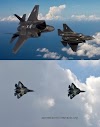When the F-16 and MiG-29 first took to the skies in the late 1970s and early 1980s, they represented the pinnacle of East-West air combat design philosophies. The American-made F-16 Fighting Falcon prioritized multirole versatility, speed, and fly-by-wire agility. The Soviet MiG-29 Fulcrum, by contrast, was built for raw dogfighting prowess and high maneuverability in close-range air combat. Over four decades later, both aircraft remain active in dozens of countries, with upgraded variants still serving as the backbone of many air forces. But which one truly dominates in a head-to-head engagement?
Design Philosophy: West vs. East
The F-16 was designed with one goal: achieve air superiority at a cost-effective price. Lightweight, agile, and packed with avionics, it became the standard multirole fighter across NATO and allied nations. Its frameless bubble canopy, side-stick controller, and fly-by-wire system were revolutionary for the time. The MiG-29, on the other hand, reflected the Soviet emphasis on speed, simplicity, and survivability. It features twin engines, short takeoff/landing capability, and a rugged airframe built to operate from unprepared runways. Its focus: close-in dogfighting and performance under extreme conditions.
Performance Specifications
| Feature |
F-16 Fighting Falcon |
MiG-29 Fulcrum |
| Max Speed |
Mach 2.0 |
Mach 2.25 |
| Service Ceiling |
50,000+ ft |
59,000 ft |
| Thrust-to-Weight Ratio |
~1.095 |
~1.09–1.25 (varies by variant) |
| Max Range |
2,622 miles (with drop tanks) |
1,430 miles (with drop tanks) |
| Avionics |
Advanced radar & ECM |
Simpler, robust Soviet tech |
| Weapons Capacity |
17,000+ lbs |
8,800 lbs |
While the MiG-29 outperforms the F-16 in raw speed and climb rate, the F-16 takes the lead in operational range and avionics integration—key for long-duration missions and modern network-centric warfare.
Maneuverability and Dogfighting
Both fighters are highly agile, but with different styles. The MiG-29’s thrust vectoring and high angle of attack (AoA) capabilities give it an edge in close-quarters combat. Its helmet-mounted sight and R-73 (AA-11 Archer) missile combo was a game-changer in the 1990s. The F-16, however, has evolved significantly. Modern variants (like the F-16V) feature AESA radar, advanced electronic warfare (EW) systems, and JHMCS helmet targeting, matching or surpassing the MiG-29’s legacy dogfight tech. In simulated exercises, upgraded F-16s often best older MiG-29s due to superior situational awareness.
Combat Record and Operational History
The F-16 has over 75 air-to-air kills and decades of operational deployment in major conflicts—from the Gulf War to operations over Syria. It has proven itself in both air combat and ground-attack roles. The MiG-29, while less battle-tested, has seen action in conflicts involving Iraq, Yugoslavia, Syria, and Ukraine. In many cases, its effectiveness has been hampered by limited pilot training or lack of upgrades—factors that don’t reflect the jet’s full potential.
Avionics and Pilot Interface
Early MiG-29s featured analog gauges and limited datalink systems. Although robust, their situational awareness was lower than Western standards. Later variants (like MiG-29SMT and MiG-35) improved significantly with glass cockpits, radar upgrades, and multirole functionality. The F-16 was always a pilot-friendly jet, with intuitive cockpit layout, fly-by-wire precision, and ever-evolving avionics. Modern F-16 Block 70/72 jets now feature: AESA radar (AN/APG-83) Enhanced electronic warfare suite Advanced data fusion Sniper and LANTIRN targeting pods These features make the F-16 a formidable platform in beyond-visual-range (BVR) combat—where the fight is often won before pilots see each other.
Maintenance, Cost, and Exportability
The F-16 is known for its maintainability, cost-effectiveness, and massive logistics support network. It remains one of the most exported and upgraded fighter jets globally, operated by 25+ nations. The MiG-29 is rugged but maintenance-intensive. Its twin-engine design, shorter lifespan, and lower fuel efficiency raise operational costs over time. Still, it remains popular in several Asian, African, and Eastern European countries—especially where Russian support and training are available.
Modern Upgrades and Relevance Today
F-16 Viper (Block 70/72):
AESA radar
Integrated mission computer
Conformal fuel tanks
Precision strike capability
Data link and BVR superiority
MiG-29SMT / MiG-35:
Upgraded Zhuk-ME radar
Multirole capability (air-to-air & air-to-ground)
Increased fuel range and payload
Electronic countermeasures (ECM)
Potential use of stealth-compatible weapons
While the F-16 continues to evolve within a large Western ecosystem, the MiG-29’s modernization relies on defense export deals and remains more isolated in upgrade options.
F-16 vs. MiG-29 in Simulated and Real Conflicts
In NATO exercises and Red Flag simulations, F-16s have repeatedly faced off against MiG-29s, especially German or Polish versions. Results generally favor the F-16 due to:
Superior BVR engagement tools
Better pilot training integration
Advanced avionics suites
However, when MiG-29 pilots could close the gap, the Fulcrum’s agility still posed a serious threat—especially in dogfight range under visual rules of engagement.
Which Jet Dominates the Future?
The future isn’t purely about dogfights. Warfare has shifted toward multirole flexibility, data fusion, and beyond-visual-range lethality. In that context, the F-16—especially Block 70/72 variants—has adapted well to modern threats. The MiG-29, though still deadly in a turning fight, faces challenges unless fully modernized (e.g., MiG-35). Without consistent upgrades and robust logistical support, it risks obsolescence in modern battlespaces dominated by drones, stealth fighters, and integrated radar systems.
In conclusion, in a pure close-range dogfight, the MiG-29 remains a formidable opponent. Its thrust-to-weight ratio and agility can still dominate. But in today’s air combat environment—defined by sensor range, electronic warfare, and multirole adaptability—the F-16 has a distinct edge. Its global footprint, modernization path, and network-centric combat systems make it not just a better fighter—but a smarter one.






0 Comments